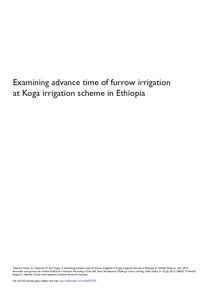Resource information
Koga irrigation scheme was developed to irrigate about 7004 ha. Furrow irrigation is the recommended method for the distribution of water. However, furrow irrigation has inherent inefficiencies due to deep percolation on the upper end and runoff at the lower end of the furrow. These losses depend on furrow length, furrow gradient, surface roughness, stream size and cutoff time. These factors play significant role to influence the advance time of irrigation and the operation rule of the scheme. This paper examines the advance time of furrow irrigation at Koga. The experiment was conducted during 2012 irrigation season in two periods (February and April). The advance time of irrigation was monitored at three discharge rates and four furrow gradients at 90–110 m furrow length. The required discharge was measured using RBC flume. The average advance time at respective discharge rates of 0.3, 0.6 and 0.8 litre/sec range from 290–460 min, 150–437 min and 100–294 min during 1st irrigation; and 115–370 min, 78–189 min and 43–217 min during 2nd irrigation. The advance time vary greatly among the discharge rates when the furrow length increases. The advance time of water at 0.5, 1.0, 2.0 and 2.5 % gradients was 236, 181, 197 and 398 min at 1st irrigation and 163, 175, 220 and 88 min at 2nd irrigation respectively. Furrow gradients and surface irregularities result in great variation of advance time. The advance time becomes shorter when the field gets smoother during 2nd irrigation. Under non-levelled and irregular field conditions, 0.6–0.8 litre/sec application rate can be suggested to irrigate 30–40 m furrow lengths in order to improve application efficiency above 60% and to optimize the daily operation rule of the overall scheme. The result of this study indicates the relevance of examining the furrow length, discharge and application time recommended in the feasibility study of irrigation schemes.



